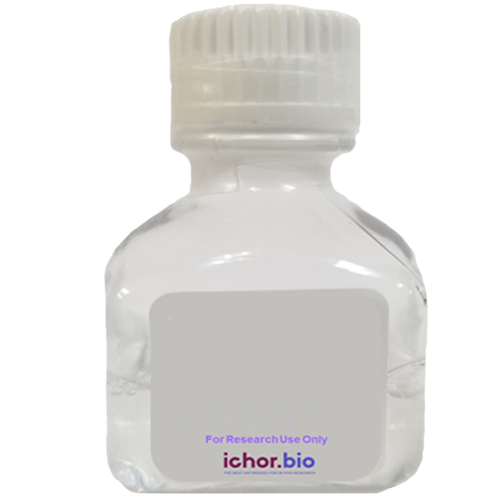Bulk anti-Human EGFR antibody (EGFR.1)
- Sizes: 5mg, 25mg, 50mg, 100mg,
- Category: ichorbio, Low Endotoxin, anti-human
- Target: EGFR
- Clone: EGFR.1
- Host: Mouse
-
 Datasheet
Datasheet
 Tech Support
Tech Support

PRODUCT DETAILS
SPECIFICATIONS |
|
|---|---|
|
PRODUCT NAME |
Bulk anti-Human EGFR antibody (EGFR.1) |
|
SPECIES REACTIVITY |
Human |
|
HOST |
Mouse |
| SPECIFICITY |
Anti-EGFR In Vivo Antibody - Low Endotoxin (EGFR.1) recognizes the (Mr 170 kDa) extracellular domain of the epidermal growth factor receptor on many cell surfaces. The EGFR mediates the initial response of cells to EGF. It has an extracellular region which binds EGF and an intracellular region which exhibits tyrosine kinase activity. The receptor phosphorylates a number of protein substrates in addition to mediating autophosphorylation |
| PURIFICATION METHOD |
|
| ANTIGEN DISTRIBUTION |
|
| IMMUNOGEN |
A431 cultured cells |
| CONCENTRATION |
|
| FORMULATION |
0.01 M phosphate buffered saline (PBS) pH 7.2, 150 mM NaCl with no carrier protein, potassium or preservatives added. |
| PURITY |
>95% by SDS-PAGE and HPLC |
| ENDOTOXIN |
≤ 1.0 EU/mg as determined by the LAL method |
| AGGRIGATION |
Aggregation level ≤ 5% |
| STORAGE CONDITION |
anti-EGFR In Vivo Antibody - Low Endotoxin (EGFR.1) is stable when stored at 2-8°C. Do not freeze. |
TARGET |
|
|---|---|
| TARGET |
EGFR |
| CLONE |
EGFR.1 |
| SYNONYMS |
|
| BACKGROUND |
The epidermal growth factor receptor (EGFR; ErbB-1; HER1 in humans) is the cell-surface receptor for members of the epidermal growth factor family (EGF-family) of extracellular protein ligands. The epidermal growth factor receptor is a member of the ErbB family of receptors, a subfamily of four closely related receptor tyrosine kinases: EGFR (ErbB-1), HER2/c-neu (ErbB-2), Her 3 (ErbB-3) and Her 4 (ErbB-4). Mutations affecting EGFR expression or activity could result in cancer. EGFR (epidermal growth factor receptor) exists on the cell surface and is activated by binding of its specific ligands, including epidermal growth factor and transforming growth factor A (TGFA) (note, a full list of the ligands able to activate EGFR and other members of the ErbB family is given in the ErbB article). ErbB2 has no known direct activating ligand, and may be in an activated state constitutively or become active upon heterodimerization with other family members such as EGFR. Upon activation by its growth factor ligands, EGFR undergoes a transition from an inactive monomeric form to an active homodimer - although there is some evidence that preformed inactive dimers may also exist before ligand binding. In addition to forming homodimers after ligand binding, EGFR may pair with another member of the ErbB receptor family, such as ErbB2/Her2/neu, to create an activated heterodimer. There is also evidence to suggest that clusters of activated EGFRs form, although it remains unclear whether this clustering is important for activation itself or occurs subsequent to activation of individual dimers. |
| UNIPROT |
|
| PATHOGEN TEST |
|
| APPLICATIONS |
Flow Cytometry, Immunocytochemistry, Immunofluorescence, IHC (Frozen), Immunoprecipitation, Neutralization, IP-Mass Spectrometry |
| APPLICATION NOTES |
Each investigator should determine their own optimal working dilution for specific applications. |
| USAGE |
Products are for research use only. Not for use in diagnostic or therapeutic procedures. |


